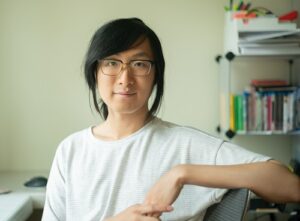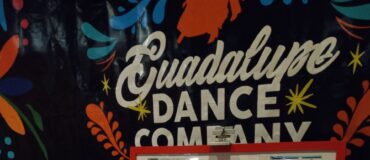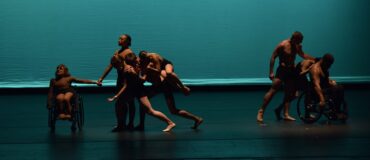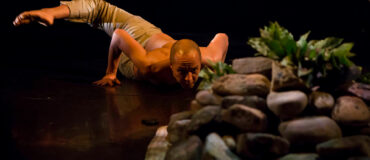By Lingyu Wang
Lingyu Wang is a 2022 Archiving and Preservation Fellow with Charya Burt Cambodian Dance. Read more about the Fellowships here. This is the third part of Lingyu’s blog. Read the second part here.
October 17, 2022: Magical Moments
I felt my heart gripped as the recording played. Neak Kru Charya sat on my side, looking into the iTunes screen. We sat there, quietly listening to the voices, hearing the slight electric hisses of radio programs. It was a magical moment. It was one of the many magical moments.

Charya with dancers Mea Lath, Julie Nuth, Callie Ok, Chamnan Renz at the Palace of Fine Arts post performance of Robam Apsara at the San Francisco Ethnic Dance Festival, 2008 Photo by Rob Burt.
Towards the end of July, I finally started my on-site work at Charya Burt’s home studio, as part of my work on the Charya Burt Cambodian Dance Digital Library. The visit was somewhat delayed because of circumstances outside of our control. But we made it. For the first few days, we went through the inventory, and at the same time, I was changing every aspect of software design in real time. Many of my earlier designs turned out to be too complex to use. Those designs did build more useful information into the database, like dance titles and productions, and the structure did look good. But to using the system would be messy. In retrospect, even if Charya and Rob had a professionally trained archivist working all the time, it would take a lot of work just to get every piece of information right. That system was good, but simply not forgiving about errors nor easy to use.
So there began our multitasking, weekend-working two weeks. To make the most out of that short time, we were doing everything at once: checking and listing all the materials we have, digitizing analog media like audio tapes and VHS tapes, transferring digital materials from old hard drives, CDs, and DVDs; stuffing every new item we found into the digital library, and updating the digital library software from the backend codes all the way to Charya’s WordPress website. When we began, we had about 650 video clips in the library, and at the end of the two weeks, we almost doubled that number with all the video clips, audio tracks, and photo albums we had added. We were finding new materials everywhere, and we brought all of them together, into the digital library.
That was how we found the piece of radio program recording (which is still on our upload backlog as I am writing, and we look forward to sharing it sometime soon). It was a 2005 special program from KALW, the local public radio station, introducing Bay Area immigrant artists from around the world. There, Charya and one of her students—then a teenager—introduced their work in traditional Cambodian dance. Neither Charya nor I expected the recording to be there. We sat there, not sure what we were listening to at the beginning, and then we heard Charya telling her story.

Charya Burt being trained by dance master Soth Sam-On at her home in Phnom Penh, Cambodia, 2000.
“Because it was almost lost during the Khmer Rouge, and it’s really a way for me to connect to my own culture, and also to preserve the classical form, the Cambodian arts, within the American culture…”
Then we heard her demonstrating her dance.
“The body is posing all the time. The whole shoulder stretching. And go.”
Charya on the radio was singing. Listening to her we were captivated. It was simply moving to hear something from a long time ago—to understand what people, including ourselves, were thinking back then, and to know how we have grown as humans over the years. There were many moments like this: when we saw video of Charya practicing dance with her teacher Master Soth Som On, when we found the home video of a young kid learning Robam Kou Tralouk (Coconut Dance) from dancers in Cambodia, or when we came across Louk Kru Thak demonstrating his brilliant Sva (Monkey) character moves. Behind all of these materials are the moments and feelings people have lived, and I was certainly lucky enough to come across so many of them. If I’m going to take a guess, I believe these moments of contact with the past are also what attract other people to archives, whether they be dancers, researchers, professional archivists, friends and families, or someone else.
At the end of the first week, Rob drove all of us to get burgers for lunch, because obviously, even though I lived in California during college, I somehow didn’t come across many burger spots. Charya loved the perfectly grilled patty with a nice, crispy crust. “The crispy. You get it? That’s the crispy you can only get eating it right here fresh.”
I took a bite. It was crispy. I wondered if I could keep that moment in an archive.
Top image: Charya Burt leading a community engagement workshop with the Wat Khmer Modesto Dance Group. Photo by Rob Burt. All photos courtesy of Charya Burt Cambodian Dance.
 Lingyu Wang (he/they) is a doctoral student in the School of Information and Library Science at University of North Carolina at Chapel Hill. His ongoing research looks at social movement archiving in Hong Kong, Mainland China, and beyond. He received a B.A. in Film and a B.S. in Computer Science from University of California, Berkeley, as well as a M.A. in Media, Culture, and Communication from New York University. Previously, he worked at the Media Resources Center at UC Berkeley, and served as graduate assistant at NYU Libraries’ Scholarly Communications Office. He has also extensively worked in film and stage productions.
Lingyu Wang (he/they) is a doctoral student in the School of Information and Library Science at University of North Carolina at Chapel Hill. His ongoing research looks at social movement archiving in Hong Kong, Mainland China, and beyond. He received a B.A. in Film and a B.S. in Computer Science from University of California, Berkeley, as well as a M.A. in Media, Culture, and Communication from New York University. Previously, he worked at the Media Resources Center at UC Berkeley, and served as graduate assistant at NYU Libraries’ Scholarly Communications Office. He has also extensively worked in film and stage productions.
Recent social movements across the globe have propelled Lingyu to study creative, performative forms of activism; people use these highly affective forms to resist erasure and build communities. Lingyu is thus drawn to Charya Burt, whose dances use a rich repertoire of mediums and techniques to discuss similar memories and histories. Together with Charya and her colleagues, he looks forward to pushing the archives’ boundaries to tell better stories and connect people with shared pasts.
____
We accept submissions on topics relevant to the field: advocacy, artistic issues, arts policy, community building, development, employment, engagement, touring, and other topics that deal with the business of dance. We cannot publish criticism, single-company season announcements, and single-company or single artist profiles. Additionally, we welcome feedback on articles. If you have a topic that you would like to see addressed or feedback, please contact communications@danceusa.org.
Disclaimer: Opinions expressed in guest posts do not necessarily represent the viewpoints of Dance/USA.






